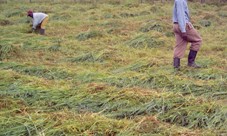How to make hay
Making hay is one of the best ways to increase the year-round carrying capacity of the farm, as forage is harvested during periods of rapid, excess growth and then fed during stress periods. As a result, livestock farmers can feed cattle and other animals for 365 days in a year.
If hay is harvested at the proper stage of plant growth and undamaged by weather, it can provide nutrients at the lowest possible cost, except for pasture or silage. You can store grass as hay or silage depending on a number of considerations. In dry areas like most parts of Kenya especially Eastern and North Eastern provinces, it is easier to make hay than silage. Hay can be made from any amount of grass while silage needs a lot of grass; the heat in the dry areas easily spoils silage while hay requires heat to dry. To make good silage, air must be removed by pressing which is very hard for a farmer without machinery, while hay just needs a lot of air to dry quickly.
Hay making
Haymaking serves two main purposes:
- To conserve excess forage during rainy season for use during the dry season when forage is scarce
- To produce a cost-effective, nutritional livestock feed
Hay can be made from planted or natural pastures. The first task is to choose when to start making hay. It is usually best at the end of rains when there is plenty of sunshine and plenty of forage. In Kenya this is usually around May/June after the long rains and October/November after the short rains when there is plenty of sunshine. When high quality hay is needed, the harvest must start at an early growth stage, such as late boot to very early head in grasses and late bud to early bloom in legumes. In mixed grass-legume stands, the decision for the first cut should be based on the grass since the grasses usually mature earlier than the legume.
Small scale operations
For small scale operations the grass-legume can be cut with a sickle when half of the grasses have flowered. The grass-legume is then spread on the field to dry turning it once a day for 3 days.
a sickle when half of the grasses have flowered. The grass-legume is then spread on the field to dry turning it once a day for 3 days.
The dried grass-legume is finally baled using a simple box with dimensions of 3ft length, 1½ ft width and 2 ft depth and strings. The box is filled with dried grass-legume then tightly packed and tied with strings on both ends. The box is then lifted to release the bale. When tightly packed in the box the dried grass-legume should weigh about 15 kg. Baling is done by tying with a rope
Large scale operations
Mowing
A mower is used for large scale operations. Whether to use a disk mower or a sickle bar mower will depend on the size of the haying operation, the local economic situation, and the preferences of the owner. When reliable custom operators are available, it is often more practical for the small operation to use these services rather than owning the mowers and making the hay on their own.
Tedding
The importance of tedding is to turn the swath and allow forage that was on the bottom or in clumps to come to the top and dry better, resulting in more uniform drying and reducing wet spots in the hay. If hay is tedded when it is too dry or if it is tedded too often, leaves will be broken off, causing a loss in forage quality and yield. The leaves are the part of the plant with the highest protein and digestibility. In most cases hay should be tedded once. Tedding should usually be done the morning after the hay is mown.
Raking
Raking the hay into a windrow allows for increased drying before the hay is baled. There are several new rake technologies that increase the openness of the windrow for drying. It is important to rake in a manner that will minimize leaf loss.
Baling
When hay is baled at higher moistures, leaf loss is reduced. However, the hay will not store properly and harmful bacteria may grow, causing health problems and possible livestock death. A baler is used for baling.
Drying Agents and Preservatives
Drying agents are useful on legumes but not on grasses. They allow the water to dry from the legume forage faster, making it possible to bale the hay a few hours sooner. Preservatives allow the hay to be baled at higher moisture content without molding and spoiling. The practical and economic value of both of these technologies depends on local product availability and cost and on the economics of the hay’s planned use.



